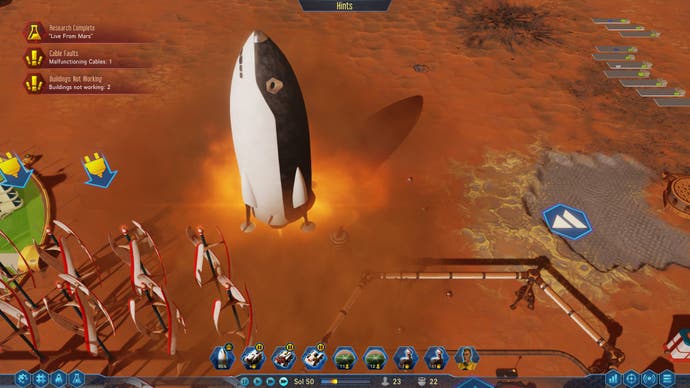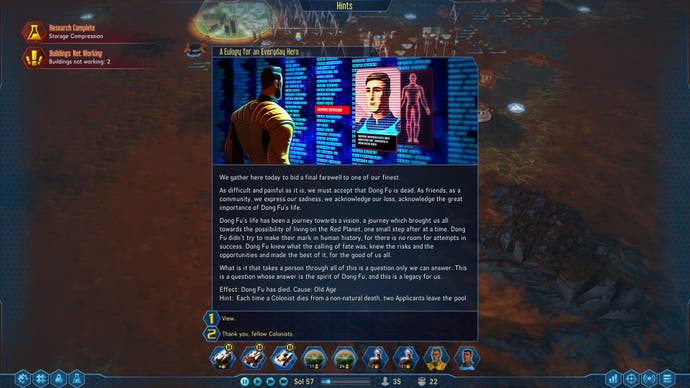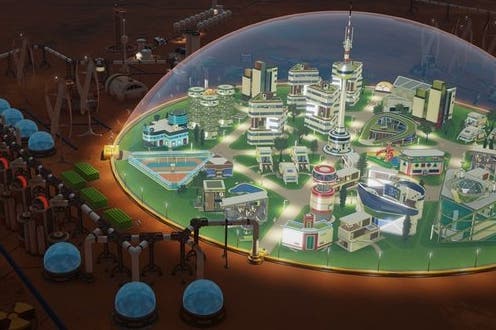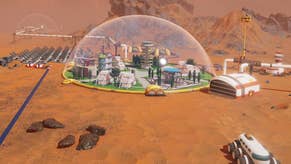Surviving Mars review - offworld, things are just itching to go awry
Dome Alone.
Survive Mars? It took me the best part of a day to decide where to land. And with good reason: there's a lot of stuff to think about from the very off here in this wonderfully detailed planet colonisation sim. I'm not sure that on my most recent attempt at surviving Mars - spoiler: I didn't - I was any quicker at finding a parking spot than I was on my initial outing.
Firstly, what to name the initial rocket? Tricky business! I tend not to rename things in games these days. Not quite so much, anyway. Soldiers? Too many of them, and they only die on you. Cities? Who is bolshy enough to think they deserve to decide what an entire city should be called? But a rocket? Christ, there is romance to a rocket. Romance and the suspicion that they will be in limited supply. I was going to call my first Surviving Mars rocket Feynman, but I couldn't bring myself to type that in given the dim view he sometimes took of the whole space mission stuff. So I went with Hawking. He has been in all our minds this week, of course, and he has always struck me as the kind of man who would enjoy getting his name stuck on a rocket.
What to pack in the rocket? An eternity of fretting. (This is why I've never progressed very far with Dwarf Fortress, which Surviving Mars, at times, kind of reminds me of.) And then the landing zone. This stuff is crucial. Not only do you get to spin a beautiful globe of Mars to pick your spot, probably choosing, your first few times, between a few suggestions the game has made for you in advance, when you finally do pick that spot you then have to pick a smaller spot within it. You use up a few probes to reveal the terrain in any sectors that look promising - nice and flat for building stuff - and then you try to slot yourself in between resources. Concrete's crucial in the early game. Metals would be nice. You can make oxygen pretty much anywhere and ditto electricity. What you're really looking for, I think, is water. Your first landing brings no people with it, just drones, and with drones you try to get the essentials running - oxygen, electricity, water - and then you can build your first habitation dome, plug it into the grids and pipes and start thinking about making food and calling in some actual human crew.
Early on there's a lot of this kind of stuff: connecting things to power sources, plumbing things in, learning which resources various buildings need, working out how to conserve the excess power and water and oxygen that you're eventually creating. Surviving Mars is dense and knotty from the start: solar panels - stop me if you've guessed this - require sunlight to work their alchemy. They unplug you at night, while turbines don't work as well if you build them in a valley. Concrete factories chuck dust everywhere, as do landing spaceships, and this dust damages everything. The cables you string across the landscape get worn through and start sparking, the pipes can get hit by meteors or just spring leaks because pipes are basically massive jerks.

What makes it all comprehensible, though - and while it takes a few minutes, even the stupidest colonist like me will get there eventually - is that every individual thing works very simply in and of itself. Take that first dome: you're going to need oxygen and electricity and water, and once you've served the production problems you can just hook them up. The more complex resources? Well, hopefully you brought some of them on your starter shuttle, to get you through the period of early expansion. Anything that requires humans to make - and fancier resources often do - will have to wait for humans to arrive, and for humans to arrive they have to be able to eat and breathe.
Another thing that gets you through the hard stuff is that, man, it all looks so wonderful. Shadows move slowly across the red soil as the day passes, solar panels fold neatly into the ground as darkness falls. The degree of control you have over the parts of your toybox - this is the kind of game where you can tell a factory to stop production over night if you fancy - is matched by the intricacy of the visual simulation. You know a machine is getting clogged with dust because it starts to look a bit pinkish and gritty: Martian conjunctivitis. You know a waste area needs expanding because it's filled up with neat piles of rubble.
Bringing life to all this stuff, before the humans arrive, are the drones, which will only work within certain areas - proximity to shuttles or drone hubs. These kinds of things both drive and control the pace of your outward expansion. Alongside building things, drones are a bit like neuroglia, I think: they keep everything ticking over as long as they have resources to do so. When they don't have the resources to do so, Surviving Mars displays a very convincing eagerness to spiral out of control terribly, terribly swiftly.

It's all those simple things, working together in close proximity. A factory fails and you find that you don't have the resources to repair it. Because the factory was making other resources - and because it's failed - suddenly you're out of two resources at once. Snowball Mars. Sure, if you're playing one of the easier game arrangements you might have a bunch of shuttles ready to shunt any resources you need over from earth, but doing that too often is going to tank your economy and then you've got another problem to go along with your breaking factories.
Humans, as you might have guessed, only complicate things. The little domes they live in, with their glass bubble tops, reinforce the idea that Martian colonists are basically lab rats, and the game is eager to double down on this notion. Humans have a range of traits and impulses and skills, but for my first few games mine were terribly willing to develop gambling addictions or alcoholism. I wasn't building enough of the right kinds of facilities for them, and I was forcing them to work at night, which was probably a drag. Also, though, Philip K. Dick was right: Mars just brings out the worst in people.
Despite everything that can go wrong - and despite my uncertainty as to whether this is ultimately a city builder or a survival game - there is a winning kind of optimism to proceedings that keeps me going even when Mars grinds me down. It's there in the beautiful tech screen where research can be spent on perks that scroll far into the future - smart buildings that need less maintenance, planetary survey boosters that don't require power or upkeep. Just when I think I couldn't love this screen any more, one of the tooltips drops in a quote from the great William Osler. Swoon!

This optimism! It's there in the gloriously busy animations that become visible when you zoom in to watch a drone repairing cabling, in the sense of wonder when you investigate a distant anomaly only to find the bones of Beagle 2 and realise afresh: Oh, god, yes, I'm actually on Mars, aren't I? It's there in the industrious sprawl of the game, buildings of increasing ingenuity spreading out from a core of electricity and pipework that starts to feel like a central nervous system.
If you are the kind of person who needs all this to be going somewhere, Surviving Mars has you covered. Mission evaluation goals crop up as you play, and each campaign builds in narrative thrust around a selection of mysteries - mysteries that aren't fundamentally that mysterious, if we're all being honest, because you know they're coming from the off. The purest pleasures, though, are the quiet rewards of hard work and a tidy mind: colonies that stretch across an entire map, every section explored and covered with busy robots and busy people beetling away without losing their minds or wrecking the economy. The steady click and purr of optimisation.
At times, with a sim like this, success can seem kind of disgusting, as unfettered wilderness is buried alive beneath factories. Here, though, it genuinely seems to say something positive about spirit. This is a game that manages to remain optimistic about human can-do while never forgetting that Mars looks like a bit of a dive and it's going to be properly awful trying to live there. Awful, but interesting. We will go to Mars to find out who we actually are.













